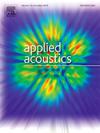基于深度学习声场高阶压力矢量的声源深度估计
IF 3.4
2区 物理与天体物理
Q1 ACOUSTICS
引用次数: 0
摘要
本文提出了一种利用声场高阶压力矢量估计深海窄带声源深度的深度学习方法。该方法采用ResNet-18神经网络学习一阶和二阶压力向量与震源深度之间的非线性相关性。与基于入射角空间变化轨迹估计震源深度的传统方法相比,该方法不需要长时间的监测,并且可以提供更准确的深度估计。首先,通过匹配场处理(MFP)方法验证了使用高阶压力矢量进行震源深度估计的可行性。然后使用BELLHOP模型生成的高阶压力矢量副本训练ResNet-18神经网络,建立声压矢量特征与震源深度之间的映射。模拟结果表明,深度z方向的压力矢量对深度估计的贡献更大。该方法还考虑了震源深度、震源频率、接收器深度和声速剖面变化的影响。在大多数情况下,源深度估计的均方根误差(RMSE)保持在20 m以下,表现出稳定可靠的性能。最后,利用南海一阶压力矢量深度z方向的实验数据,进一步验证了该深度学习方法用于震源深度估计的可行性和有效性。本文章由计算机程序翻译,如有差异,请以英文原文为准。
Source depth estimation based on higher-order pressure vectors of sound field by deep learning
This paper presents a deep learning approach for estimating narrow-band source depth in the deep ocean using higher-order pressure vectors of the sound field. The method employs a ResNet-18 neural network to learn the nonlinear correlation between the first- and second-order pressure vectors and the source depth. Compared to traditional methods that estimate source depth based on the incident angle spatial variation trajectory, this approach does not require long-duration monitoring and provides more accurate depth estimations. First, the feasibility of using higher-order pressure vectors for source depth estimation is demonstrated through the Matched Field Processing (MFP) method. A ResNet-18 neural network is then trained using higher-order pressure vector replicas generated by the BELLHOP model, establishing a mapping between sound pressure vector features and source depth. Simulations indicate that pressure vectors in the depth z-direction contribute more significantly to depth estimation. The approach also considers the impact of variations in source depths, source frequencies, receiver depths, and sound velocity profiles. In most scenarios, the Root Mean Square Error (RMSE) for source depth estimation remained below 20 m, demonstrating stable and reliable performance. Finally, experimental data from the South China Sea, utilizing first-order pressure vectors in the depth z-direction, further validated the feasibility and effectiveness of this deep learning approach for source depth estimation.
求助全文
通过发布文献求助,成功后即可免费获取论文全文。
去求助
来源期刊

Applied Acoustics
物理-声学
CiteScore
7.40
自引率
11.80%
发文量
618
审稿时长
7.5 months
期刊介绍:
Since its launch in 1968, Applied Acoustics has been publishing high quality research papers providing state-of-the-art coverage of research findings for engineers and scientists involved in applications of acoustics in the widest sense.
Applied Acoustics looks not only at recent developments in the understanding of acoustics but also at ways of exploiting that understanding. The Journal aims to encourage the exchange of practical experience through publication and in so doing creates a fund of technological information that can be used for solving related problems. The presentation of information in graphical or tabular form is especially encouraged. If a report of a mathematical development is a necessary part of a paper it is important to ensure that it is there only as an integral part of a practical solution to a problem and is supported by data. Applied Acoustics encourages the exchange of practical experience in the following ways: • Complete Papers • Short Technical Notes • Review Articles; and thereby provides a wealth of technological information that can be used to solve related problems.
Manuscripts that address all fields of applications of acoustics ranging from medicine and NDT to the environment and buildings are welcome.
 求助内容:
求助内容: 应助结果提醒方式:
应助结果提醒方式:


